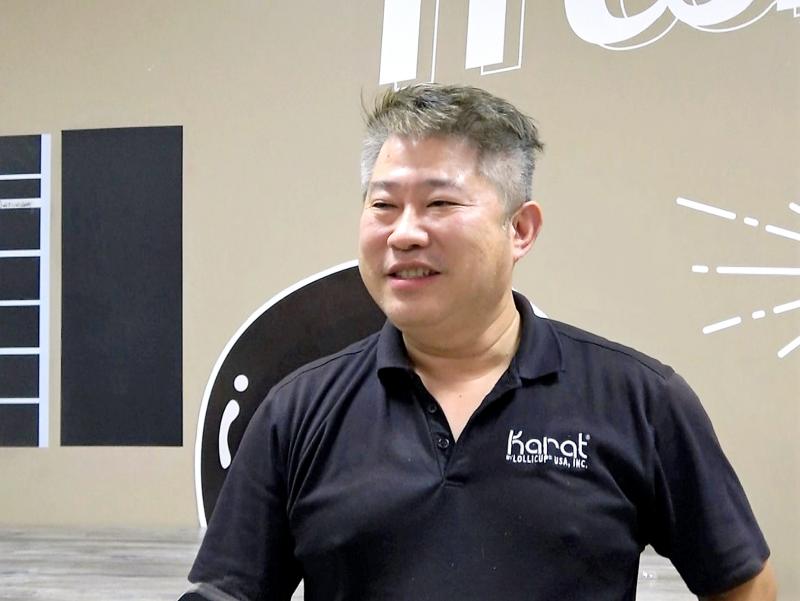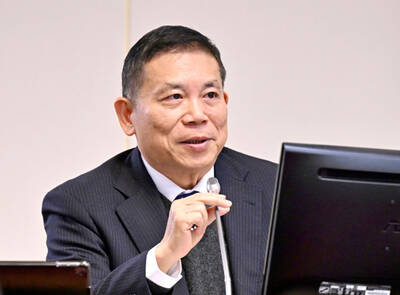Starting with a humble beverage shop, a Taiwanese-American boba tea entrepreneur has transformed his business into a multimillion-dollar packaging giant that is publicly listed on the NASDAQ.
On Wednesday last week, Alan Yu (俞宗明) shared his success story when hosting a delegation of members from the Taipei Economic and Cultural Office in Los Angeles (TECO LA), the Taiwanese- American Chamber of Commerce of Greater Los Angeles (TACCLA) and media representatives.
The meeting was held at Yu’s 4,645m2 facility in Chino, California, which serves as the principal executive and administrative headquarters for his companies Karat Packaging Inc and Lollicup USA Inc, as well as a manufacturing plant for select products.

Photo: CNA
Karat is a publicly listed company valued at approximately US$368 million.
However, Yu came from humble beginnings. His first foray into the food and beverage industry began in 2000, when he opened his first boba tea shop in San Gabriel, California, with his partner, Marvin Cheng (鄭光宏).
Soon, Lollicup USA Inc was founded, focusing initially on the establishment, franchising and licensing of boba tea stores throughout the US.
Yu said that he was the person who coined “boba tea,” the English term used to describe the internationally popular Taiwanese beverage.
Yu said that instead of using “pearls,” the term commonly used in Taiwan to describe the beverage’s tapioca balls, he settled on “boba,” an older Mandarin slang used to describe the voluptuous figure of a woman, to associate the snack with the supersizing of day-to-day items commonly practiced in the US.
The operation quickly went from a single venue to more than 60 stores in 2006.
To guarantee quality control at all of their stores, the company in 2004 expanded its focus to include the distribution of supplies for the entire boba tea industry in the US.
In 2014, the firm began distributing and manufacturing products under a new brand, Karat, because of growing demand for their packaging products in the country’s food service industry.
Karat was eventually incorporated in September 2018 as the holding company for Lollicup.
Asked about the key to his success, Yu said that it is always important to keep risk diversification in mind while growing a company.
Dedication, adaptability and perseverance in problem-solving also helped the company grow, he said.
Echoing Yu’s statement, Lollicup and Karat’s chief operation officer, Joanne Wang (王姿容), used examples of how the company has spread its focus over the past 20 years, all the while coming face-to-face with unforeseen obstacles such as the Sept. 11, 2001, attacks, the 2008 financial crisis and the COVID-19 pandemic.
“There are a lot of people out there in the business of boba tea products, but we have been able to achieve what others could not, such as decreasing packaging volume to lower logistics expenses, and selecting the right kind of plastic to minimize breakage during transport,” Wang said.
Liu Lun-cheng (劉倫正), who heads TECO LA’s Economic Division, told the meeting that Yu’s ability to transform a small beverage shop into a NASDAQ-listed company fully encompassed and represented the hardworking spirit of Taiwanese.
TACCLA president Lisa Liu (劉雅薇) said that it was an impressive feat for a Taiwanese-American company to penetrate the mainstream US market, gaining clients from popular food chains such as TGI Fridays.
Today, Lollicup reaches across six US states, with distribution centers, supply stores, manufacturing plants and warehouses in Hawaii, Washington, California, Texas, South Carolina and New Jersey.

UNCERTAINTY: Innolux activated a stringent supply chain management mechanism, as it did during the COVID-19 pandemic, to ensure optimal inventory levels for customers Flat-panel display makers AUO Corp (友達) and Innolux Corp (群創) yesterday said that about 12 to 20 percent of their display business is at risk of potential US tariffs and that they would relocate production or shipment destinations to mitigate the levies’ effects. US tariffs would have a direct impact of US$200 million on AUO’s revenue, company chairman Paul Peng (彭雙浪) told reporters on the sidelines of the Touch Taiwan trade show in Taipei yesterday. That would make up about 12 percent of the company’s overall revenue. To cope with the tariff uncertainty, AUO plans to allocate its production to manufacturing facilities in

Taiwan will prioritize the development of silicon photonics by taking advantage of its strength in the semiconductor industry to build another shield to protect the local economy, National Development Council (NDC) Minister Paul Liu (劉鏡清) said yesterday. Speaking at a meeting of the legislature’s Economics Committee, Liu said Taiwan already has the artificial intelligence (AI) industry as a shield, after the semiconductor industry, to safeguard the country, and is looking at new unique fields to build more economic shields. While Taiwan will further strengthen its existing shields, over the longer term, the country is determined to focus on such potential segments as

TAKING STOCK: A Taiwanese cookware firm in Vietnam urged customers to assess inventory or place orders early so shipments can reach the US while tariffs are paused Taiwanese businesses in Vietnam are exploring alternatives after the White House imposed a 46 percent import duty on Vietnamese goods, following US President Donald Trump’s announcement of “reciprocal” tariffs on the US’ trading partners. Lo Shih-liang (羅世良), chairman of Brico Industry Co (裕茂工業), a Taiwanese company that manufactures cast iron cookware and stove components in Vietnam, said that more than 40 percent of his business was tied to the US market, describing the constant US policy shifts as an emotional roller coaster. “I work during the day and stay up all night watching the news. I’ve been following US news until 3am

COLLABORATION: Given Taiwan’s key position in global supply chains, the US firm is discussing strategies with local partners and clients to deal with global uncertainties Advanced Micro Devices Inc (AMD) yesterday said it is meeting with local ecosystem partners, including Taiwan Semiconductor Manufacturing Co (TSMC, 台積電), to discuss strategies, including long-term manufacturing, to navigate uncertainties such as US tariffs, as Taiwan occupies an important position in global supply chains. AMD chief executive officer Lisa Su (蘇姿丰) told reporters that Taiwan is an important part of the chip designer’s ecosystem and she is discussing with partners and customers in Taiwan to forge strong collaborations on different areas during this critical period. AMD has just become the first artificial-intelligence (AI) server chip customer of TSMC to utilize its advanced